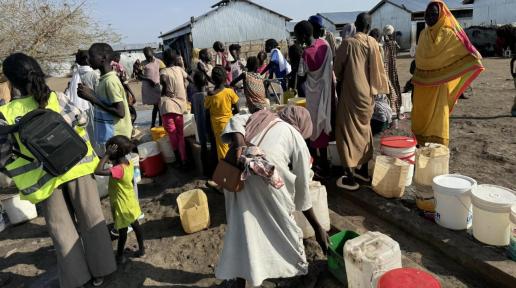→ 225K IDPs in Upper Nile
→ 158K IDPs in camps and displacement sites
→ 36K in Malakal Protection of Civilians site
→ 682K returnees in Upper Nile
The Upper Nile State, bordering Sudan and with Malakal as its capital, has 13 counties with varying dynamics ranging from relatively peaceful and stable areas, to those where conflict, intercommunal violence and flooding have impacted communities.
As of October 2025, the state accommodates over 225,000 internally displaced persons (IDPs), including over 36,000 living in South Sudan’s last Protection of Civilians site on UNMISS’ base in Malakal. According to the CCCM Cluster, over 158,000 live in camps and displacement sites. Additionally, there are 210,000 refugees and asylum seekers throughout the state, mainly in the Maban camps.
Return movements are dynamic. Upper Nile hosts the highest number of returnees in South Sudan, with more than 680,000 people estimated to have returned as of 2025 from within the country and from abroad. Since fighting erupted in Sudan in April 2023, over 1 million South Sudanese have returned, 80 per cent of whom entered through the border in Renk county.

Roadmap for solutions
In February 2024, an Area-based Durable Solution Roadmap was finalized and developed with the support of the relevant authorities in South Sudan, in particular the State Government in Upper Nile, and in coordination with all interested humanitarian, development and peace actors operating in Malakal over the period between July to December 2023. The Roadmap is in line with the Upper Nile State Development Plan as well as the Durable Solutions Strategy for the whole country.
The Roadmap reflects an agreement between the State Government of Upper Nile and humanitarian, development and peace actors to support the following durable solution activities for displaced and affected communities:
- Establishing safe and sustainable settlements for IDPs and returnees on Government-identified and/or non-disputed lands
- Reclaiming individual plots/land for IDPs and returnees title holders via Government processes and linking to support systems to reestablish themselves
- Strengthening area-based support services and livelihoods for vulnerable returnees from the Sudan crisis to enable them to reestablish themselves in their return destination, as well as support for the voluntary return of other IDPs
- Strengthening basic/public services infrastructure within Malakal and other key return locations to enhance return conditions, including enhancing security, rule of law, water supply, education, healthcare and livelihoods
- Expanding peace and community cohesion activities, strengthening community-based and Government-led projects that aim to minimize conflict between communities and seeking to prevent the risk of any further displacement
Durable solutions are coordinated through the State Level Taskforce on Solutions (SLTFS), chaired by the Relief and Rehabilitation Commission (RRC) and UNHCR, and linked to the national Solutions Taskforce. Complementary structures include the Malakal POC Transition Taskforce (co-led by UNMISS and humanitarian partners), the Area-Based Coordination Forum in Malakal, and the Inter-Cluster Coordination Group chaired by OCHA.

Timeframe
A three-year timeframe has been proposed for the roadmap, with a phased approach based on existing resources and expanded as funding permits.

Securing multi-year, flexible resources for infrastructure, governance capacity and livelihood support is critical to ensure durable outcomes. Significant progress has been made, particularly in land identification, settlements planning and coordination mechanisms, but gaps in basic services, security guarantees and livelihoods opportunities have constrained the sustainability of returns and local integration. Without additional investment, both returnees and IDPs risk remaining dependent on humanitarian assistance.
For more information:
Ulf Joel Andersson, Area-Based Coordinator for the Upper Nile, anderssj@unhcr.org




